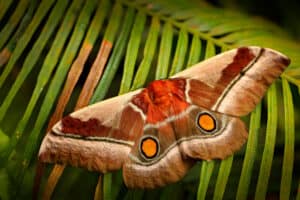Speaking of the most common moths in Ohio, the Buckeye State faces an ongoing battle with gypsy moths. So much so that the gypsy moth’s population numbers are closely evaluated and announced each year. Ohio has three management zones when it comes to the gypsy moth: eradication, suppression, and slowing the spread.
Despite the problems with the gypsy moth (mostly because of their voracious appetite for some of the most beautiful trees in the state), Ohio is home to many other species. Thankfully, not all of them are problematic.
The unfortunate issue with moths is that people like to associate them with either mischief (crop and garden destruction) or those dusky, pesky variations that like to fly headlong into your porch light. The reality is, of the many moths on our list, some are every bit as beautiful and fascinating as butterflies.
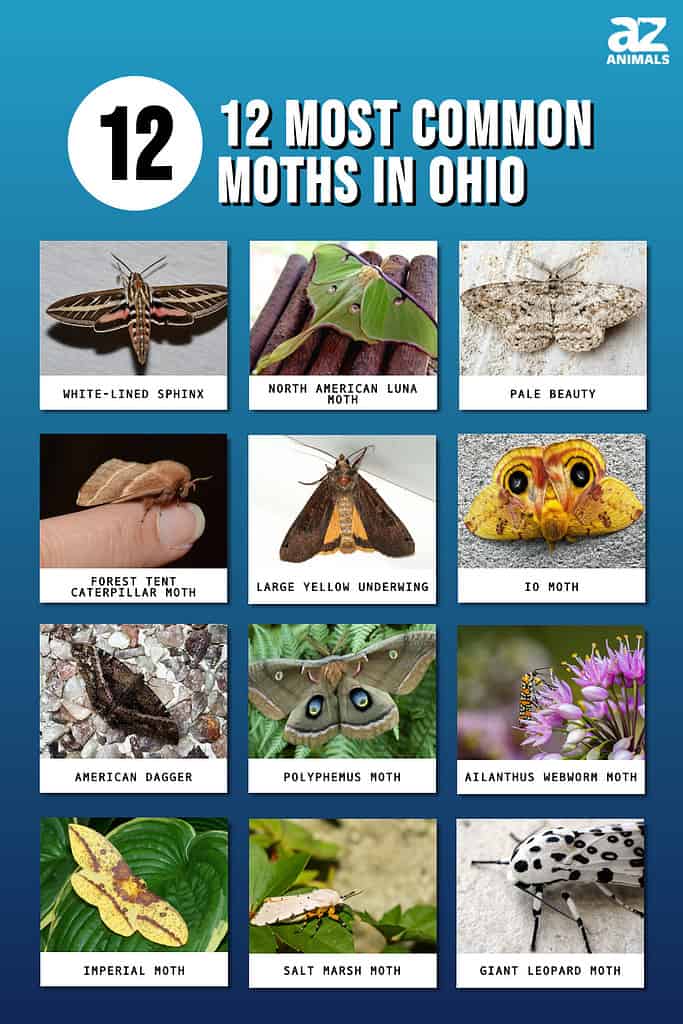
How To Tell The Difference Between Moths And Butterflies
Before we get started with the most common moths in Ohio, it’s important to understand the differences between moths and butterflies. The good news is, the differences are a lot more obvious than most people realize. Once you know, it’s easy to remember the next time.
- Moths at rest keep their wings open, while most butterflies close theirs in the vertical position
- Moths often feature a more washed-out look, with less color variation and vividness than butterflies
- Moths mostly come out at night (nocturnal) and butterflies are often out and about throughout the day (diurnal)
- Moths typically have fuzzy, thick antennae, versus the thin, narrow antennae of butterflies
- Moths are mostly thicker, and heavier-looking, while butterflies feature a delicate, streamlined appearance
- Moth caterpillars have silk cocoons versus butterfly caterpillars and their hard shell pupa
Some of these physical characteristics are very obvious, like the thickness of the body, the large antennae, and the way they lay their wings at rest. If you spend a lot of time observing moths and butterflies, you’ll notice something else as well. Moths may lack the color pop and vivid display of butterflies (this isn’t always the case), but they make up for it in patterning.
They often have fascinating patterns, with dips, whorls, curves, and outlines that draw the eye in as if you’re standing in front of a hypnotist. Moths are sometimes fuzzy and strangely cute as well.

“I see you!” Some moths are super fuzzy and cute, in a strange sort of way.
©Sanit Fuangnakhon/Shutterstock.com
Most Common Moths in Ohio
Now that you know for sure what you’re looking at, we’ll dive right into one of nature’s most stunning and fascinating creatures. In this case, it’s moths in Ohio. There are well over 1,000 townships throughout the Buckeye State. That’s a lot of artificial light in the evening hours, and a veritable light show when it comes to attracting moths. Here are some of the most common moths in Ohio, coming to a porch light near you!
1. White-Lined Sphinx (Hyles lineata)
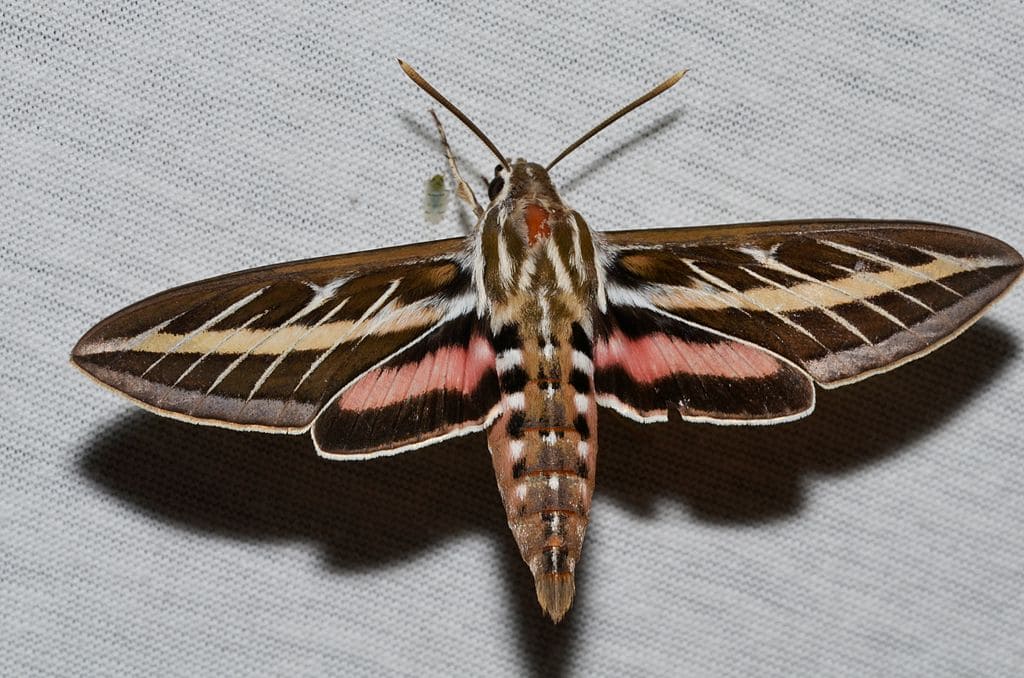
White-lined sphinx against a solid background.
©Andy Reago & Chrissy McClarren, CC BY 2.0 , via Wikimedia Commons – License
Now this is one incredible-looking moth and the perfect choice to get the ball rolling. It has a wingspan of between 2″ and 3″, and an interesting blend of tan/brown and red patterns on its fore and hindwings. The body tapers off at a strong point where the head and the abdomen end, giving it an arrowlike or projectile shape.
The body is thick as well, with a light degree of fuzz that’s just enough to see the texture of it. Its antennae are short and narrower than many moths, though thicker than the common butterfly. The white-lined sphinx behaves much like a hummingbird, sipping from flowers and hovering in place. Their flower of choice is honeysuckle, but they’ll also go after penstemon, petunias, and lilac.
2. North American Luna Moth (Actias luna)
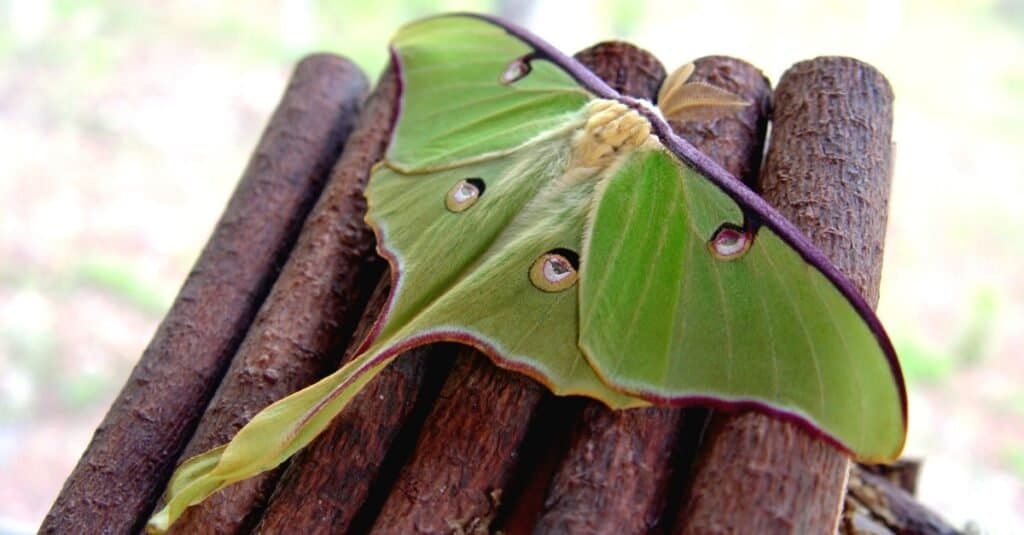
The luna moth, a beautiful green animal, only lives for a week to reproduce.
©David Hampton/Shutterstock.com
The next on our most common moths in Ohio list is a big one. The North American luna moth reaches between 4″ and 7″ in width, with bright green forewings and hindwings. The hindwings taper off in an elaborate C-shape, ending in dull points. The body is nearly hidden among the giant wings and is slightly yellow in appearance.
However, the yellow is only an appearance, viewing the body through the slightly translucent wings. They are white and fuzzy, with spots that look like eyes on the front and the back end. There are also four interesting-looking spots on the fore and hindwings as well, one for each of the four.
3. Pale Beauty (Campaea perlata)

Pale beauty uses its colors as a fantastic camouflage.
©Ben Sale from UK, CC BY 2.0 , via Wikimedia Commons – License
This “Pale Beauty” is just one of the common moths in Ohio. If this is what’s considered common, we’ll gladly have more of it. Though it looks mostly white, with tiny black and brown patterning, the pale beauty is normally more of a very pale green or slightly yellow.
It’s also smaller than the photos make it look, with a wingspan of only 1″ to 2″ or so. They like to come out during the cooler months, but not in the winter or in the summer. The more outdoor lights you have, the better your odds of spotting one, since they are highly attracted to artificial light.
4. Forest Tent Caterpillar Moth (Malacosoma disstria)
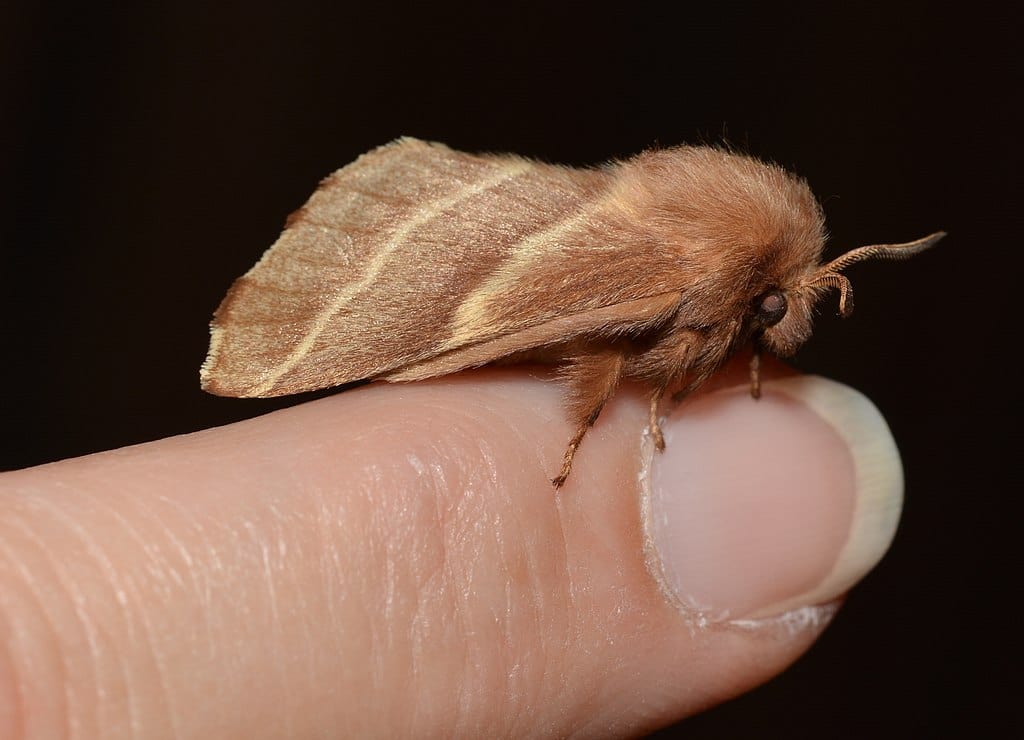
The fuzzy forest tent moth is barely larger than a fingernail.
©https://commons.wikimedia.org/wiki/File:-_7701_%E2%80%93_Malacosoma_americana_%E2%80%93_Eastern_Tent_Caterpillar_Moth_%2847990074762%29.jpg – License
This moth is a bit more on the rugged, raggedy side when it comes to aesthetics. It’s a highly fuzzy moth, with a yellow/tan appearance and a dark brown bar that passes from one wing tip to the tip of the opposite wing.
It has thick, fern-like antennae that are half as long as they are. The forest tent caterpillar moth looks just like a tent in a forest, albeit in 1″ to 2″ size. This moth is easily one of the most common moths in Ohio and the only moth you’re likely to see in every part of the state.
5. Large Yellow Underwing (Noctua pronuba)
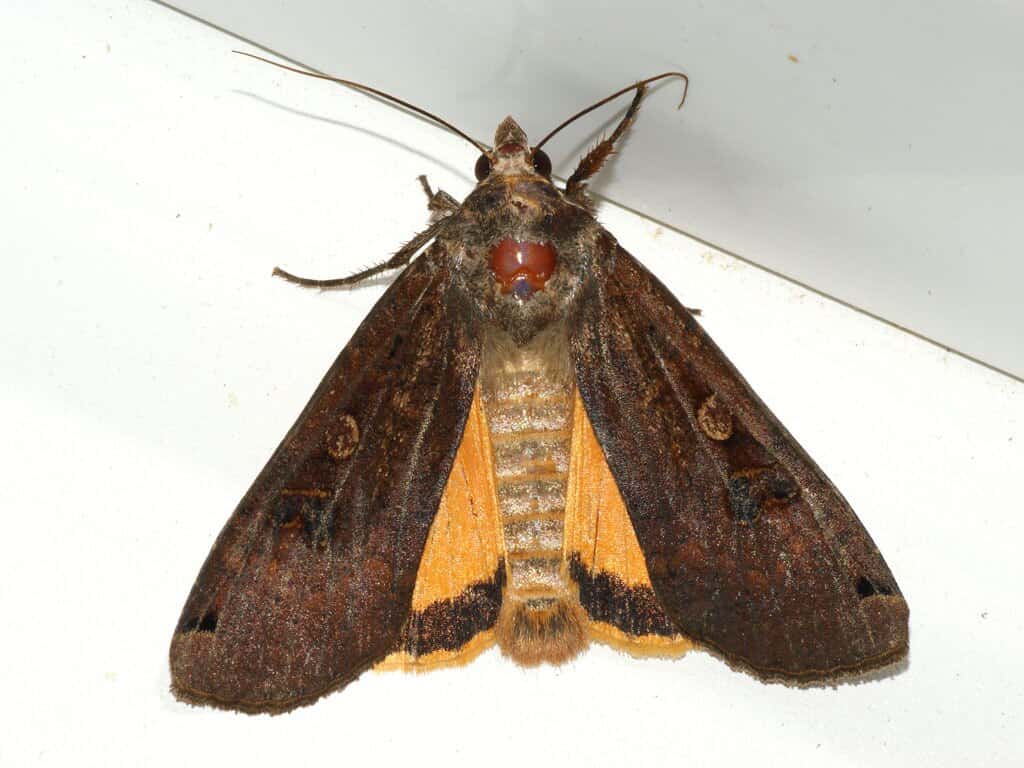
Large yellow underwings are uniquely colorful but not the most stunning of moths.
©https://commons.wikimedia.org/wiki/File:Noctua_pronuba_-_Large_yellow_underwing_-_%D0%9B%D0%B5%D0%BD%D1%82%D0%BE%D1%87%D0%BD%D0%B0%D1%8F_%D1%81%D0%BE%D0%B2%D0%BA%D0%B0_%D0%B1%D0%BE%D0%BB%D1%8C%D1%88%D0%B0%D1%8F_%2841046087152%29.jpg – License
Probably not the prettiest of the bunch, especially with its distinctly roach-like legs, the large yellow underwing isn’t as large as some other moths on this list. Its wingspan is roughly 1.5” to 2.5”. As its name implies, the underwing is a bright to semi-grungy yellow, with a brown band running along the edges.
The forewings are almost entirely brown, with brown and black patterning that’s often difficult to see. One of the more telling signs that it’s a large yellow underwing is the slightly bulbous red spot on its back, just behind the eyes. They love bushes but are kind of generic in their habitations, often showing up in parks or front porches.
6. Io Moth (Automeris io)
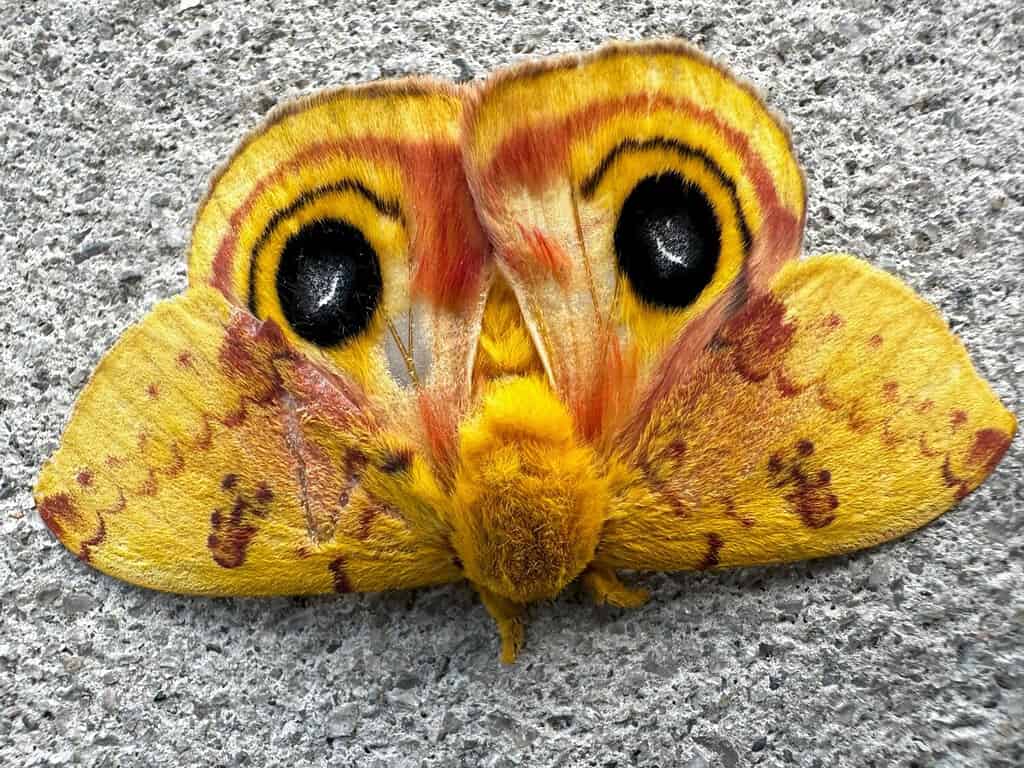
The io moth is one of the most beautiful of moths.
©Linardo_respado/Shutterstock.com
The io moth is a moderate size with a stunning appearance. As one of the common moths of Ohio, it looks anything but. Its fore and hindwings are a bright, vivid yellow with an enormous black spot on each hindwing. To top it off, shades of red outline the hindwings, with red splotches across the forewings.
It’s also a very fuzzy moth with short, stubby, fuzzy antennae. An adult io moth has a wingspan from 2″ to 4″ and only comes out at night. If you want to appreciate the colors of an io moth, hope for a very bright light outside.
7. American Dagger (Acronicta americana)

The American dagger is gifted in its ability to choose matching backgrounds for effective camo.
©ZakStanczyk/Shutterstock.com
This may not be the most colorful moth in the world but, if you look closely, the patterning is fantastic. The American dagger isn’t a dagger by any means, but the tiny circles, ridged cream bars, black teardrops, and varying shades of brown across its fore and hindwings are mesmerizing.
The American dagger only reaches between 2″ and 2.5” in width, so you have to look pretty close to take it all in. The term “dagger” refers to the knife-shaped markings found along its forewings, though it’s easy to lose the shape as your mind takes in all the other unique patterns.
8. Polyphemus Moth (Antheraea polyphemus)

A polyphemus moth (
Antheraea polyphemus) rests on a fern in a garden.
©LightShaper/Shutterstock.com
It seems like most of the common moths in Ohio are the types of moths no one ever lays eyes on. The Polyphemus moth is a prime example—stunning in its unique, velvet patterns, and huge to boot. The average polyphemus will reach between 4″ and 6″ in width.
The hindwings feature bright blue patterns that fade into black at the top and yellow/green at the bottom, much like a peacock. Their backs are extremely fuzzy, to the point of being hairy but in a thick, wool aesthetic. The polyphemus moth prefers anything from swampy regions to city life but only lives for fewer days than fingers on one hand.
9. Ailanthus Webworm Moth (Atteva aurea)

The Ailanthus Webworm Moth
closely resembles some sort of colorful beetle, rather than a moth.©JJ Gouin/iStock via Getty Images
You’re excused for thinking the ailanthus webworm moth is a species of pretty beetle. It hardly resembles a moth, at least in the imaginings of most. They’re also very tiny, only reaching .5″ to 1″ in width. However, like most moths, they have fore and hind wings, both of which feature bright orange bands with white dots, each dot outlined in black.
The ailanthus only has a lifespan of about a month, so it hurries through life with a sense of understandable urgency. They make good pollinators while they’re alive, however, and mostly stick to green leaves and various grasses to sustain themselves.
10. Imperial Moth (Eacles imperialis)
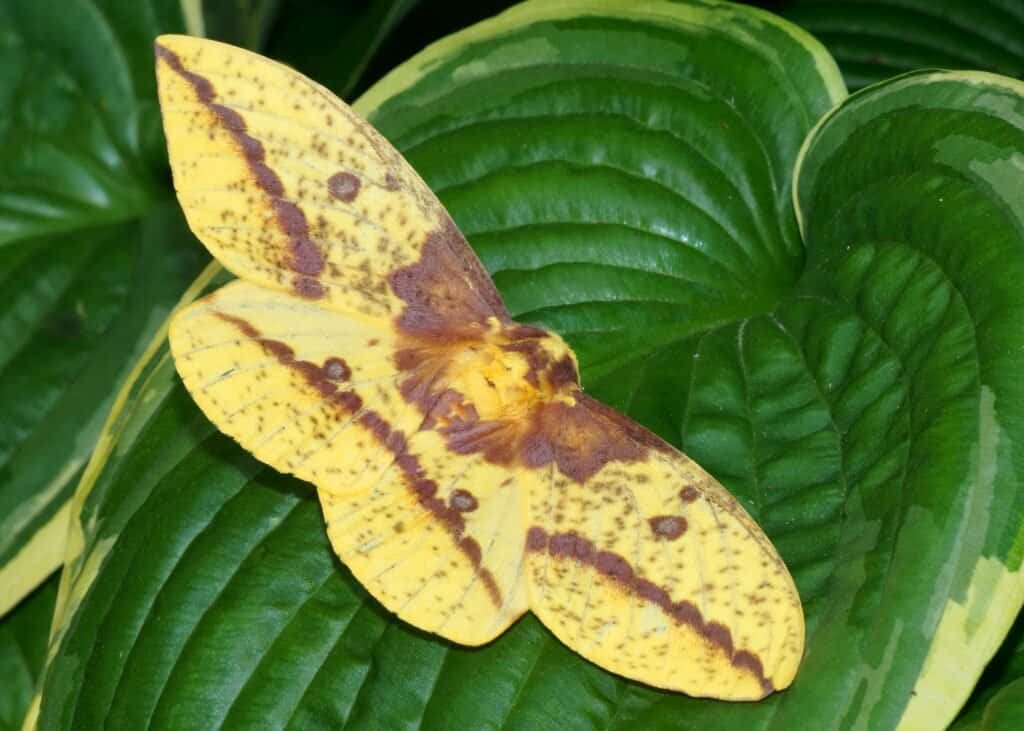
Imperial moths resemble dying leaves in the middle stages of decay. This fools predators into letting them be.
©Matt Jeppson/Shutterstock.com
The imperial moth is yet another fascinating species of the most common moths in Ohio. Its coloration is faded but purposeful; the yellow, dying leaf appearance of fading yellow and red forces potential predators to get bored and move on.
While the above red/yellow appearance is common, imperial moths will oftentimes sport a purple, pink, orange, or brown variation. They are quite large as well, reaching between 3″ and 7″ in overall width. Though it’s considered to be one of the common moths in Ohio, the population is dwindled away in recent years.
11. Salt Marsh Moth (Estigmene acrea)

Salt marsh moth,
Estigmene acrea.
©Jay Ondreicka/Shutterstock.com
This moth is truly a sight to see when its wings are fully spread. From the abdomen down, it features encircling yellow bands with midnight black ovals in each band. The salt marsh moth’s hindwings match the yellow of the abdomen, with black spots as well, though it in a more spattered appearance.
The forewings are snow white, with black spots and centering on a wide, fuzzy white head. Two narrow, black antennae poke out from the head, sometimes featuring yellow bands and sometimes all black. The salt marsh moth is roughly 1.5″ to 3″ in width, much smaller than most of the pictures circulating the web suggest.
12. Giant Leopard Moth (Hypercompe scribonia)
Last but not least on our list of most common moths in Ohio, is the giant leopard moth. It’s easy to see where it gets its name, as it’s essentially a snow leopard in moth form. The underlying, white fuzz is stunningly bright, with deep black spots throughout, some of which have tiny white circles within.
Though its name implies that it is the largest moth on this list, it only reaches between 2″ and 3.5″ in width. While that doesn’t suggest largeness, compared to the other moths on this list, it’s still quite large considering the gorgeous patterning across its body and wings.
Summary of the 12 Most Common Moths In Ohio
| # | Moth | Classification |
|---|---|---|
| 1 | Noctua pronuba | Hyles lineata |
| 2 | North American Luna Moth | Actias luna |
| 3 | Pale Beauty | Campaea perlata |
| 4 | Forest Tent Caterpillar Moth | Malacosoma disstria |
| 5 | Large Yellow Underwing | Noctua pronuba |
| 6 | Io Moth | Automeris io |
| 7 | American Dagger | Acronicta americana |
| 8 | Polyphemus Moth | Antheraea polyphemus |
| 9 | Ailanthus Webworm Moth | Atteva aurea |
| 10 | Imperial Moth | Eacles imperialis |
| 11 | Salt Marsh Moth | Estigmene acrea |
| 12 | Giant Leopard Moth | Hypercompe scribonia |
The photo featured at the top of this post is © iStock.com/Tomasz Klejdysz
Thank you for reading! Have some feedback for us? Contact the AZ Animals editorial team.





